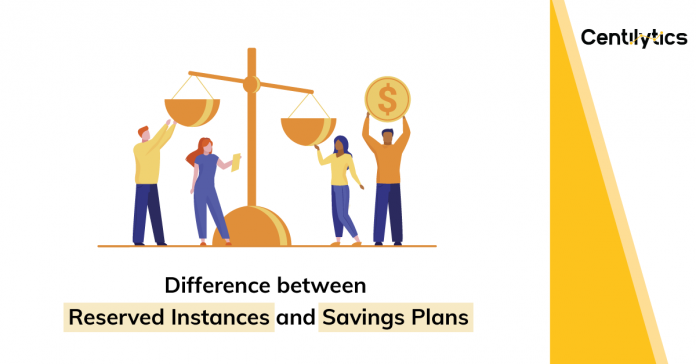For any organization, migration to the cloud starts with the promise of cost savings and easy scalability. However, a majority of organizations often do not see the promise being fulfilled as they scale, and their cloud infrastructure becomes complex in the absence of best practices.
All the players of the cloud industry, whether OEMs, MSPs, or an intelligent Cloud Management Platform such as Centilytics, are committed to reducing cloud costs for users and ensuring savings on cloud bills. These entities take several measures to ensure a reduction in cloud expenses. Two such measures to reduce cloud bills are Reserved Instances and Savings Plans — introduced by cloud providers in a bid to control costs and ease the life of users. Let’s take a look at how Reserved Instances and Savings Plan work and how they are different from each other.
What are Reserved Instances?
The term Reserved Instances (RIs) is pretty self-explanatory — it refers to the reservation of instances in the cloud. Organizations can leverage RIs to reduce their cloud expenses while ensuring their business-critical workloads are executed at optimum efficiency. Introduced as a concept for discounted billing, Reserved Instances allow organizations to commit to a specified usage level for a fixed period of time instead of opting for on-demand usage.
Users get the capability to set attributes such as platform, region, tenancy, instance type, and many more, and these resources will be charged at a discounted rate of the Reserved Instance. While opting for Reserved Instances, an organization can commit to an exact amount of resources required by them beforehand and receive a discounted price rather than higher on-demand prices.
What are Savings Plans?
The cost benefits that come with Reserved Instances involve a lot of planning, prediction, and execution, which can prove to be quite complex. Savings Plans is an AWS exclusive feature, and the cloud giant claims that Savings Plans provide greater flexibility to users with the same cost-benefit outcome as reservations.
However, Savings Plans also are far from a simple arrangement, especially for organizations that use their own basic tools to manage their cloud infrastructure. Just like in the case of Reserved Instances, the resources are priced differently under AWS Savings Plan as compared to the regular pricing. Currently, Savings Plans only offer EC2 and Fargate services for a commitment of a 1- or a 3-year period.
AWS offers two distinct Savings Plans — Compute Savings Plans and EC2 Instance Savings Plans.
The Compute Savings Plans can automatically be applied to EC2 and Fargate usage, resulting in savings of up to 66% while also being the more flexible of the two. In comparison, the latter comes with up to 72% savings on the usage of any instance family regardless of the region.
Reserved Instances v/s Savings Plans — A Comparison?
|
Type |
Reserved Instances |
Savings Plans |
|
Average Discount |
Up to 72% |
Up to 72% |
|
Commitment |
1- or 3-year period |
1- or 3-year period |
|
Payment |
Upfront, partial, or monthly |
Upfront, partial, or monthly |
|
Family |
Fixed |
Flexible |
|
Size |
Fixed |
Flexible |
|
Operating System |
Fixed |
Flexible |
|
Tenancy |
Fixed |
Flexible |
|
Capacity Reservation |
Flexible |
Fixed |
|
Account Limits |
Flexible |
Fixed |
|
Supported Services |
EC2, DynamoDB, Redshift, RDS, Elastic Cache |
EC2, Fargate, Lambda |
|
Geography |
Fixed |
Flexible |
Conclusion
Dealing with Reserved Instances or Savings Plans can be challenging, but they do offer significant savings on your cloud expenses. Not to mention Savings Plan is an AWS-only feature, so if you run a multi-cloud, RIs is the way to go. This is where Centilytics — an intelligent Cloud Management Platform — steps in as it handles both, Reserved Instance and Savings Plans to ensure you can maximize the ROI from your cloud.
Centilytics starts by identifying the type of resources or savings option your organization requires while ensuring superior management of the deployed workloads. Our intelligent console also keeps a check on all the wasted resources and provides recommendations based on your usage of your cloud infrastructure.
To learn more about whether your cloud requires Reserved Instances or Savings Plans, click here and start your free trial of Centilytics today.


